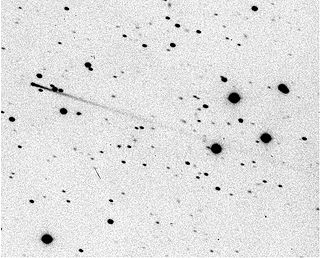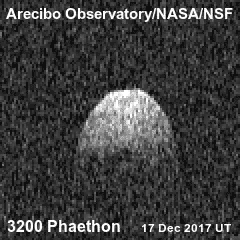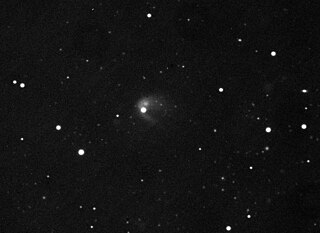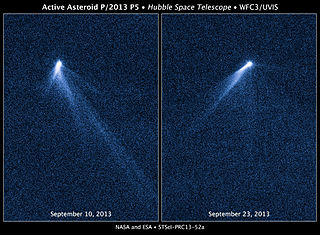
The Solar System is the gravitationally bound system of the Sun and the objects that orbit it. It formed about 4.6 billion years ago when a dense region of a molecular cloud collapsed, forming the Sun and a protoplanetary disc. The Sun is a typical star that maintains a balanced equilibrium by the fusion of hydrogen into helium at its core, releasing this energy from its outer photosphere. Astronomers classify it as a G-type main-sequence star.

4015 Wilson–Harrington is an active asteroid known both as comet 107P/Wilson–Harrington and as asteroid 4015 Wilson–Harrington. It passed 0.4 AU (60 million km) from Earth on 20 July 2022 and then passed perihelion on 24 August 2022. It seldom gets brighter than apparent magnitude 16. It will return to perihelion on 25 November 2026.

Comet Elst–Pizarro is a body that displays characteristics of both asteroids and comets, and is the prototype of active asteroids. Its orbit keeps it within the asteroid belt, yet it displayed a dust tail like a comet while near perihelion in 1996, 2001, and 2007.

3200 Phaethon, provisionally designated 1983 TB, is an active Apollo asteroid with an orbit that brings it closer to the Sun than any other named asteroid. For this reason, it was named after the Greek Hero, Phaëthon, son of the sun god Helios. It is 5.8 km (3.6 mi) in diameter and is the parent body of the Geminids meteor shower of mid-December. With an observation arc of 35+ years, it has a very well determined orbit. The 2017 Earth approach distance of about 10 million km was known with an accuracy of ±700 m.

596 Scheila is a main-belt asteroid and main-belt comet orbiting the Sun. It was discovered on 21 February 1906 by August Kopff from Heidelberg. Kopff named the asteroid after a female English student with whom he was acquainted.

Active asteroids are small Solar System bodies that have asteroid-like orbits but show comet-like visual characteristics. That is, they show a coma, tail, or other visual evidence of mass-loss, but their orbits remain within Jupiter's orbit. These bodies were originally designated main-belt comets (MBCs) in 2006 by astronomers David Jewitt and Henry Hsieh, but this name implies they are necessarily icy in composition like a comet and that they only exist within the main-belt, whereas the growing population of active asteroids shows that this is not always the case.
60558 Echeclus is a centaur, approximately 60 kilometers (37 miles) in diameter , located in the outer Solar System. It was discovered by Spacewatch in 2000 and initially classified as a minor planet with provisional designation 2000 EC98 (also written 2000 EC98). Research in 2001 by Rousselot and Petit at the Besançon observatory in France indicated that it was not a comet, but in December 2005 a cometary coma was detected. In early 2006 the Committee on Small Bodies Nomenclature (CSBN) gave it the cometary designation 174P/Echeclus. It last came to perihelion in April 2015, and was expected to reach about apparent magnitude 16.7 near opposition in September 2015.
118401 LINEAR (provisional designation 1999 RE70, comet designation 176P/LINEAR) is an active asteroid and main-belt comet that was discovered by the Lincoln Near-Earth Asteroid Research (LINEAR) 1-metre telescopes in Socorro, New Mexico on September 7, 1999. (118401) LINEAR was discovered to be cometary on November 26, 2005, by Henry H. Hsieh and David C. Jewitt as part of the Hawaii Trails project using the Gemini North 8-m telescope on Mauna Kea and was confirmed by the University of Hawaii's 2.2-m (88-in) telescope on December 24–27, 2005, and Gemini on December 29, 2005. Observations using the Spitzer Space Telescope have resulted in an estimate of 4.0±0.4 km for the diameter of (118401) LINEAR.

354P/LINEAR, provisionally designated P/2010 A2 (LINEAR), is a small main-belt asteroid that was impacted by another asteroid sometime before 2010. It was discovered by the Lincoln Near-Earth Asteroid Research (LINEAR) at Socorro, New Mexico on 6 January 2010. The asteroid possesses a dusty, X-shaped, comet-like debris trail that has remained nearly a decade since impact. This was the first time a small-body collision had been observed; since then, minor planet 596 Scheila has also been seen to undergo a collision, in late 2010. The tail is created by millimeter-sized particles being pushed back by solar radiation pressure.

311P/PanSTARRS also known as P/2013 P5 (PanSTARRS) is an active asteroid discovered by Bryce T. Bolin using the Pan-STARRS telescope on 27 August 2013. Observations made by the Hubble Space Telescope revealed that it had six comet-like tails. The tails are suspected to be streams of material ejected by the asteroid as a result of a rubble pile asteroid spinning fast enough to remove material from it. This is similar to 331P/Gibbs, which was found to be a quickly-spinning rubble pile as well.

C/2017 K2 (PanSTARRS) is an Oort cloud comet with an inbound hyperbolic orbit, discovered in May 2017 at a distance beyond the orbit of Saturn when it was 16 AU (2.4 billion km) from the Sun. Precovery images from 2013 were located by July. It had been in the constellation of Draco from July 2007 until August 2020. As of June 2022, the 3-sigma uncertainty in the current distance of the comet from the Sun is ±6000 km.

249P/LINEAR is a periodic Jupiter-family comet with an orbital period of 4.61 years. It was discovered by LINEAR on 19 October 2006. It is only active for a brief period around perihelion.

259P/Garradd is a Jupiter-family comet and active asteroid with an orbital period of 4.5 years. It was discovered in images obtained on 2 September 2008 as part of the Siding Spring Survey by Gordon J. Garradd.

324P/La Sagra is an active asteroid with an orbital period of 5.44 years. It has been found to be active in more than one perihelia, indicating that the source of activity is sublimation.

2I/Borisov, originally designated C/2019 Q4 (Borisov), is the first observed rogue comet and the second observed interstellar interloper after ʻOumuamua. It was discovered by the Crimean amateur astronomer and telescope maker Gennadiy Borisov on 29 August 2019 UTC.

C/2014 UN271 (Bernardinelli–Bernstein), simply known as C/2014 UN271 or Comet Bernardinelli–Bernstein (nicknamed BB), is a large Oort cloud comet discovered by astronomers Pedro Bernardinelli and Gary Bernstein in archival images from the Dark Energy Survey. When first imaged in October 2014, the object was 29 AU (4.3 billion km; 2.7 billion mi) from the Sun, almost as far as Neptune's orbit and the greatest distance at which a comet has been discovered. With a nucleus diameter of at least 120 km (75 mi), it is the largest Oort cloud comet known. It is approaching the Sun and will reach its perihelion of 10.9 AU (just outside of Saturn's orbit) in January 2031. It will not be visible to the naked eye because it will not enter the inner Solar System.
(155140) 2005 UD is an asteroid on an eccentric orbit, classified as a near-Earth object of the Apollo group. It was discovered on 22 October 2005, by the Catalina Sky Survey at the Catalina Station in Arizona, United States. 2005 UD is thought to be a possible fragment of 3200 Phaethon due to its similar orbit, although it is not dynamically associated with the Geminid meteor stream produced by Phaethon.
Active Asteroids is a NASA partner citizen science project that successfully discovered active asteroids, including main-belt comets, quasi-Hilda objects, and Jupiter family comets. The project is hosted on the Zooniverse platform and is funded by a NSF Graduate Research Fellowship Program. It uses images from the Dark Energy Camera (DECam) to search for tails around asteroids and other minor planets. The research team is led by Colin Orion Chandler. As of April 2024 about 8300 volunteers carried out 6.7 million classifications of 430 thousand images. At the time only 60 active asteroids were known and 16 new active objects were discovered by this project, significantly increasing the sample of known objects.

P/2013 R3 (Catalina–PanSTARRS) was an active main-belt asteroid that disintegrated from 2013 to 2014 due to the centrifugal breakup of its rapidly-rotating nucleus. It was discovered by astronomers of the Catalina and Pan-STARRS sky surveys on 15 September 2013. The disintegration of this asteroid ejected numerous fragments and dusty debris into space, which temporarily gave it a diffuse, comet-like appearance with a dust tail blown back by solar radiation pressure. Observations by ground-based telescopes in October 2013 revealed that P/2013 R3 had broken up into four major components, with later Hubble Space Telescope observations showing that these components have further broken up into at least thirteen smaller fragments ranging 100–400 meters (330–1,310 ft) in diameter. P/2013 R3 was never seen again after February 2014.

483P/PanSTARRS is a pair of active main-belt asteroids that split apart from each other in early 2010. The brightest and largest component of the pair, P/2016 J1-A, was discovered first by the Pan-STARRS 1 survey at Haleakalā Observatory on 5 May 2016. Follow-up observations by the Canada-France-Hawaii Telescope at Mauna Kea Observatory discovered the second component, P/2016 J1-B, on 6 May 2016. Both asteroids are smaller than 1 kilometre (0.62 mi) in diameter, with P/2016 J1-A being roughly 0.6 km (0.37 mi) in diameter and P/2016 J1-B being roughly 0.3 km (0.19 mi) in diameter. The two components recurrently exhibit cometary activity as they approach the Sun near perihelion, suggesting that their activity is driven by sublimation of volatile compounds such as water.















